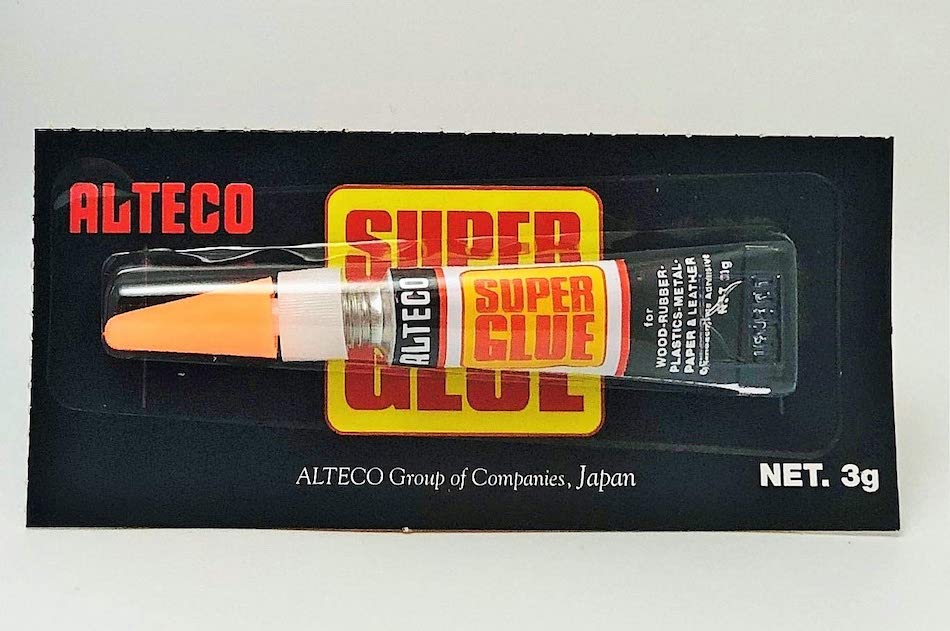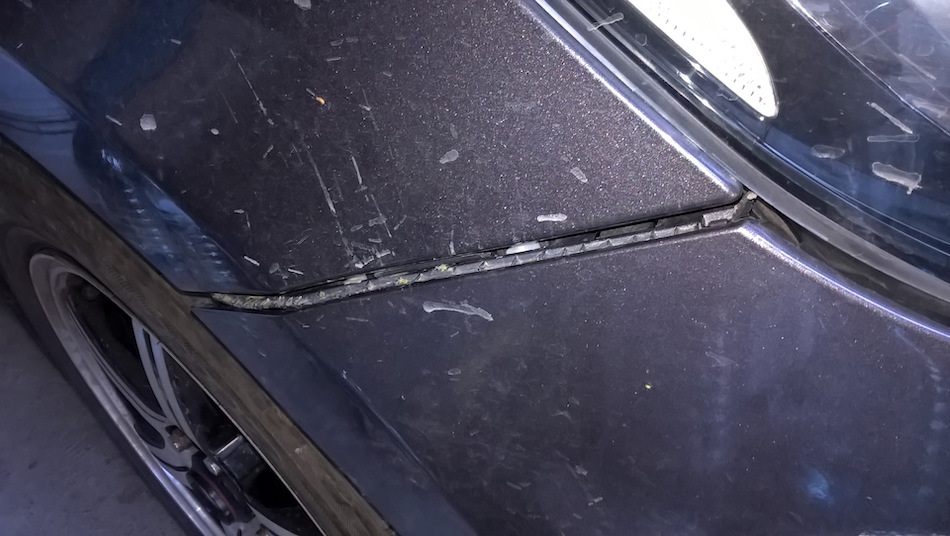
How and how to glue the bumper on the car with your own hands
Content
From the outside, coat all cracks with hot glue (use a gun) or plasticine. This will prevent the epoxy from flowing out during drying and will seal the future seam. Seal the outside with adhesive tape over the hot melt adhesive. This will additionally keep the shape of the bumper during the repair process.
The main function of a car bumper is to protect the car body from damage. Elements are the first to receive blows in a collision, hitting a high obstacle, with inaccurate maneuvers. Sometimes a damaged part can be glued on its own.
But you need to carefully choose the composition: glue to glue the bumper on the car with your own hands is not always suitable for a specific type of part. Before choosing repair compounds, it is necessary to know exactly what material the front pad is made of. So, epoxy-based adhesives will be useless for repairing carbon or fiberglass body kits.
Possible damage
Major bumper damage:
- cracks, through holes;
- scratches, chipped paintwork, dents.
Through damage to metal bumpers and their amplifiers are repaired by welding, patching, less often with epoxy. Plastic, fiberglass, made by hot and cold molding - gluing using special compounds. Non-through damage (scratches, dents) is pulled out, straightened after removing the part from the car.

Bumper repair
Each bumper is marked by the manufacturer. International Certification Letters help you quickly identify what material the part is made of.
| Marking letters | Material |
| ABS (ABS plastic) | Polymer alloys of butadiene styrene, characterized by increased rigidity |
| RS | Polycarbonate |
| RVT | Polybutylene |
| RR | Polypropylene regular, medium hardness |
| PURE | Polyurethane, minimum weight |
| RA | Polyamide, nylon |
| PVC | Polyvinylchloride |
| GRP/SMC | Fiberglass, has a minimum weight with increased rigidity |
| RE | Polyethylene |
Why cracks appear
A cracked plastic bumper is always the result of mechanical shock, as the material does not corrode or wear out. It can be a collision with an obstacle, an accident, a blow. For polyethylene structures, which are more soft, cracks are an uncharacteristic malfunction. Even after a significant accident, body kits are crushed and deformed. Fiberglass, plastic and plastic bumpers crack more often.
What damage cannot be repaired on your own
Since 2005, one of the leading research technical centers AZT continues to test the bodies of manufacturers for repairs. According to the study of plastic bumpers, the center confirmed the recommendations of automakers for the repair of plastic and fiberglass body elements and issued a guide with catalog numbers for repair kits. According to experts, any damage can be repaired on a plastic bumper.
In practice, repair after a serious accident is impractical: it is cheaper to buy a new part. But drivers successfully eliminate minor damage on their own:
- chips;
- cracks up to 10 cm;
- dents;
- breakdowns.
Masters do not recommend repairing if part of the element is completely torn off and lost, with a large area of \uXNUMXb\uXNUMXbthe diagonal gap of the lateral and central parts. It is possible to glue the bumper on the car tightly only taking into account the material of the part and applying the appropriate repair method.
What materials are used to glue the bumper
Depending on how to glue the car bumper, materials and tools are chosen. To repair a crack in a plastic or fiberglass part, the fiberglass bonding method is used. You will need:
- special glue or adhesive tape;
- polyester resin (or epoxy);
- fiberglass;
- degreaser;
- auto enamel;
- putty, car primer.
From the tools use the grinder. With its help, the repair edge of the bumper is prepared and the final grinding is carried out.

Grinding the bumper grinder
When using the heat sealing method for gluing plastic overlays, it is necessary to correctly determine the heating temperature. After overheating, the plastic becomes brittle, unable to hold the reinforcing mesh, which is placed to fix the crack. This method is considered difficult and is more suitable for thermoplastic parts.
Adhesive based on polyurethane
Properly selected adhesive based on polyurethane has high adhesion, quickly fills the damage array, and does not spread. After drying, it is easy to sand, has maximum vibration resistance and withstands significant force.
One of the proven compositions that allow you to glue the bumper on the car with your own hands is the Novol Professional Plus 710 repair kit. Glue works with plastic, metal. Does not lose characteristics when applied to acrylic primers. After the composition has hardened, the surface is ground with sandpaper, polished and painted.

Bumper adhesive kit
It is also possible to glue a plastic car bumper with a two-component adhesive based on Teroson PU 9225 polyurethane. The composition is designed to repair most elements made of ABC plastic, PC, PBT, PP, PUR, PA, PVC (polyethylene, polyurethane, polypropylene) plastics. The manufacturer recommends applying the composition with a glue gun, and for large cracks, use fiberglass to reinforce the structure.
Universal superglue
You can glue a car bumper when you don’t know exactly what class of plastic it is made of, you can use superglue. The line of synthetic compounds offers more than a hundred items. Before gluing, the plastic can not be prepared, the composition dries from 1 to 15 minutes, after stripping it keeps the paint well.
Four brands are the most popular.
- Alteco Super Glue Gel (Singapore), breaking force - 111 N.
- DoneDeal DD6601 (USA), 108 N.
- Permatex Super Glue 82190 (Taiwan), maximum tensile strength - 245 N.
- The Power of Superglue (PRC), 175 N.

Height Super Glue Gel
Superglue is good for gluing gaps that cross the edge of the part, filling cracks. It is recommended to withstand the compression time of the parts. After drying, the remaining glue is removed with fine abrasive sandpaper.
Sealing with fiberglass and epoxy
The most popular way to repair a plastic bumper. Epoxy glue is chosen two-part - it must be prepared before use. Epoxy resin and hardener are sold in a separate container.
Using a one-component epoxy adhesive is much more convenient because the composition does not need to be prepared. But experienced craftsmen note that two-component gives greater strength.
Adhesive selection rules
It is necessary to start the repair with the choice of adhesive composition, which, after hardening, should:
- form an integral structure with a bumper;
- do not burst in the cold;
- do not exfoliate under the influence of high temperatures;
- be resistant to aggressive reagents, gasoline, oil.
To glue a plastic bumper on a car with your own hands, use the following compositions:
- Weicon Construction. The adhesive has high elasticity and strength. After hardening does not crack. To strengthen the structure during the repair of large cracks and faults, it is used with fiberglass.
- AKFIX. Adhesive for spot bonding. Suitable if a crack or a through dent is not more than 3 cm. When using the primer, you can not apply it.
- Power Plast. Firmly seals large cracks. The composition is resistant to aggressive reagents, water. One-component adhesive is toxic, it is necessary to work with gloves and a respirator.
Thermoplastic and thermoset adhesives are used if the bumper is immediately painted after repair, in which case the composition will fix the crack as reliably as possible.
Bonding technology
Repair consists of several mandatory steps that cannot be skipped or swapped.
- Removing the bumper. If the plastic lining is cracked in several places, before removing it, you need to fix it with tape from the outside (so that the part does not fall apart).
- Preparatory work includes the choice of adhesive composition, selection of tools, bumper cleaning, surface preparation. All work is carried out in a warm, well-ventilated area.
- Gluing process.
- Grinding.
- Painting.

Glued bumper
If it is necessary to repair a small crack, chip or deep scratch, after preparing the bumper, glue is applied from the outside, filling the gap with the compound, and lightly pressing the plastic. If the crack is significant, crosses the edge of the lining, use epoxy glue and fiberglass.
Prepare
Preparing the bumper before gluing with epoxy and fiberglass step by step (if there is a significant crack):
- Wash bumper, dry.
- Sand the damaged area with coarse sandpaper, this will increase adhesion, degrease with white spirit.
- Fix the fracture site.
From the outside, coat all cracks with hot glue (use a gun) or plasticine. This will prevent the epoxy from flowing out during drying and will seal the future seam. Seal the outside with adhesive tape over the hot melt adhesive. This will additionally keep the shape of the bumper during the repair process.
Materials and Tools
If there is a large gap, it is necessary to seal the bumper on the car with a two-part epoxy adhesive, which is diluted before the main work. Good feedback from drivers was earned by the two-component compositions of Khimkontakt-Epoxy in the assortment, the one-component Nowax STEEL EPOXY ADHESIVE (steel 30 g) .
What you need to work:
- epoxy - 300 gr .;
- fiberglass - 2 m;
- brush;
- car primer, degreaser, car enamel;
- emery, scissors.
Repair process
Measure the required amount of fiberglass to cover the entire fracture area, cut off. Masters recommend using not fiberglass, but fiberglass to glue the bumper on the car. The material will increase the density of the seam and its strength.
Dilute the epoxy if using a two-component compound. Take 10-12 parts of resin, 1 part of hardener, mix thoroughly. Leave for 5 minutes in a warm place (20-23 degrees).
Repair process step by step:
- Lubricate the inside of the body kit with plenty of glue.
- Attach fiberglass, press it against the bumper, soak it with glue, make sure that no air remains.
- Lubricate with glue, stick the fabric in 2-3 layers.
- Apply the last layer of glue.
- Put the bumper in a warm place for 24 hours, preferably in this way to reduce the stress on the crack, but not on the side, as the resin will drain when it hardens.

Bumper painting after repair
The final step is puttying and painting. After the glue has dried on the outside, the bumper is sanded and primed, after drying it is painted.
Fiberglass bumper repair
Fiberglass body kits are marked UP, PUR, are made by hot and cold forming. The main condition for self-repair is to use resin or polyester resin as an adhesive.
It is important to remember that resin is not glue, it has a minimum percentage of adhesion to smooth surfaces. Therefore, before sizing, the surface is ground with coarse emery and carefully degreased. Fiberglass is used as a sealant. Necessary tools and materials:
- polyester resin + hardener;
- fiberglass.
How to restore the gloss and uniformity of the paintwork at the site of the crack
Sanding and priming is the last stage of work before painting. The complexity of local painting lies in the fact that it is almost impossible to pick up the original color. Even if you choose an auto enamel of the original marking, class and type, the color will still not match. The reason is simple - the color of the body kit paintwork has changed during operation.
Fully repainting the bumper is the easiest way to update a part. After painting, the part is polished with soft circles and an acrylic colorless varnish is applied, which retains the gloss of the paintwork for a long time and levels out the discrepancy in tone if it was not possible to find the original shade.

